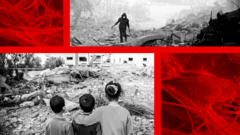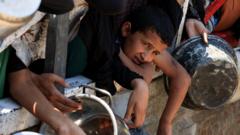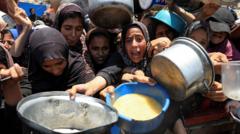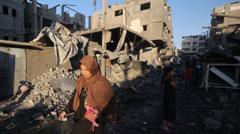With millions of tons of contaminated rubble present, the potential for increased asbestos-related diseases looms large over Gaza's population.
Concerns Rise Over Asbestos in Gaza's War-Torn Rubble

Concerns Rise Over Asbestos in Gaza's War-Torn Rubble
As military actions in Gaza expose the hidden dangers of asbestos, health experts warn of long-term health risks from toxic debris.
In Gaza, the destruction caused by ongoing military campaigns has unveiled a silent yet perilous threat: asbestos. Once a common component in construction, this hazardous mineral, now banned in numerous countries, releases invisible toxic fibers when disturbed, endangering the health of those in proximity. According to the United Nations Environment Programme (UNEP), the remnants of the buildings damaged in conflict could contain approximately 2.3 million tons of rubble tainted with asbestos, predominantly found in the roofing of older structures scattered throughout the territory's urban refugee camps.
The precarious situation is exacerbated by the densely populated environment, which complicates the ability of residents to evade inhalation of deadly fibers. “The Gaza rubble is a very, very toxic environment,” warns Professor Bill Cookson from the National Centre for Mesothelioma Research in London, highlighting the acute and chronic health issues that may arise in the coming decades, especially for vulnerable populations like children. Liz Darlison, CEO of Mesothelioma UK, reinforces this sentiment, stating, “The lives lost now are not going to end here. The legacy is going to continue.”
The critical concern lies in the long latency period associated with asbestos-related illnesses. Affected individuals typically don't show symptoms until two or six decades post-exposure, leading to grim projections of rising health issues in the region over time. Doctor Ryan Hoy emphasizes the challenge of avoiding inhalation of contaminated dust, noting, "the particles are really tiny,” making them capable of penetrating deep into the lungs.
Regrettably, the populace remains unaware of the dangers posed by asbestos while grappling with immediate life-threatening issues stemming from military offensives. Chiara Lodi, a medical coordinator for Medical Aid for Palestinians in Gaza, points out that the urgent need for food and safety overshadows health risks from dust inhalation. Many individuals have not been educated on the dangers of asbestos, leaving them vulnerable amidst reconstruction efforts.
The risks associated with asbestos exposure are extensive, not limited to mesothelioma, but also encompassing other types of lung cancers and diseases like silicosis. With the region continuing to experience heavy dust clouds from the destruction, the potential for further respiratory issues rises. Lessons drawn from historical events emphasize the catastrophic impact of toxic exposure on civilian populations, such as the lingering health effects observed in survivors of the 9/11 attacks on the US.
As plans for reconstruction surface, both the US and various Arab states are proposing strategies that must take into consideration the enormous amounts of asbestos-laden debris. Yet, experts, including UNEP representatives, caution that debris removal processes could aggravate the situation and release hazardous fibers into the air, posing additional health risks to an already suffering populace. The complexity of managing this environmental hazard aligns with a stark reality: effective remediation may take years and considerable financial resources, highlighting the urgent need for meticulous planning and public health awareness in the wake of conflict.
The precarious situation is exacerbated by the densely populated environment, which complicates the ability of residents to evade inhalation of deadly fibers. “The Gaza rubble is a very, very toxic environment,” warns Professor Bill Cookson from the National Centre for Mesothelioma Research in London, highlighting the acute and chronic health issues that may arise in the coming decades, especially for vulnerable populations like children. Liz Darlison, CEO of Mesothelioma UK, reinforces this sentiment, stating, “The lives lost now are not going to end here. The legacy is going to continue.”
The critical concern lies in the long latency period associated with asbestos-related illnesses. Affected individuals typically don't show symptoms until two or six decades post-exposure, leading to grim projections of rising health issues in the region over time. Doctor Ryan Hoy emphasizes the challenge of avoiding inhalation of contaminated dust, noting, "the particles are really tiny,” making them capable of penetrating deep into the lungs.
Regrettably, the populace remains unaware of the dangers posed by asbestos while grappling with immediate life-threatening issues stemming from military offensives. Chiara Lodi, a medical coordinator for Medical Aid for Palestinians in Gaza, points out that the urgent need for food and safety overshadows health risks from dust inhalation. Many individuals have not been educated on the dangers of asbestos, leaving them vulnerable amidst reconstruction efforts.
The risks associated with asbestos exposure are extensive, not limited to mesothelioma, but also encompassing other types of lung cancers and diseases like silicosis. With the region continuing to experience heavy dust clouds from the destruction, the potential for further respiratory issues rises. Lessons drawn from historical events emphasize the catastrophic impact of toxic exposure on civilian populations, such as the lingering health effects observed in survivors of the 9/11 attacks on the US.
As plans for reconstruction surface, both the US and various Arab states are proposing strategies that must take into consideration the enormous amounts of asbestos-laden debris. Yet, experts, including UNEP representatives, caution that debris removal processes could aggravate the situation and release hazardous fibers into the air, posing additional health risks to an already suffering populace. The complexity of managing this environmental hazard aligns with a stark reality: effective remediation may take years and considerable financial resources, highlighting the urgent need for meticulous planning and public health awareness in the wake of conflict.


















